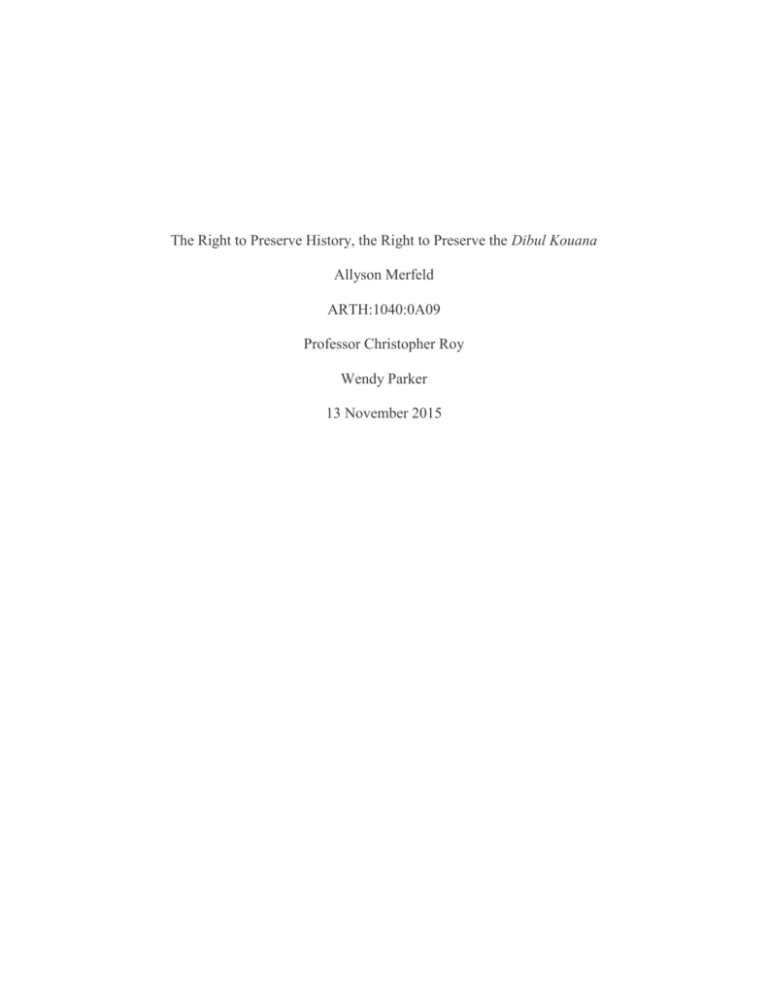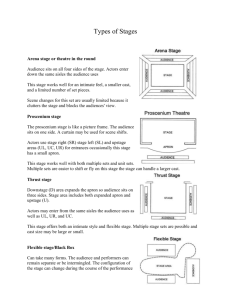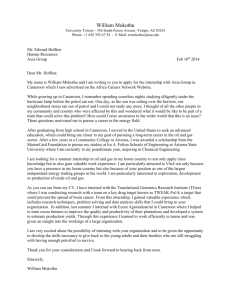Allyson Merfeld - University of Iowa Museum of Art
advertisement

The Right to Preserve History, the Right to Preserve the Dibul Kouana Allyson Merfeld ARTH:1040:0A09 Professor Christopher Roy Wendy Parker 13 November 2015 Merfeld 2 The Bana Guili of Cameroon are a people proud of their heritage, and the dibul kouana is a form of art that exemplifies this pride. Also referred to as a cache-sexe, the beaded pubic apron is worn only by Bana Guili women. During initiations, weddings, and other important ceremonies these females don the pubic coverings with a sense of self-worth. That is, until the government banned the beaded apron in 1961.1 When Cameroon gained political independence, the government unjustly put a stop to the dibul kouana, declaring women must be fully clothed; regardless, many in rural areas continue to wear the piece as a reminder of their rich history. In considering the history and symbolism behind the dibul kouana, one can understand the significance of the apron to the people and why the government’s restriction is undeserved. The composition of the piece has a direct relation to the heritage and traditions of the Bana Guili people. These details, the lines, patterns, materials, and much more, are necessary to understand to gain appreciation for the culture of the people who wear the dibul kouana. Colorful, lively, and rhythmic, the dibul kouana, also known as the woman’s apron, is an important piece in African art and history. The apron in the University of Iowa Museum of Art is from the Bana Guili people of Cameroon (Figure 1). The beaded pubic covering in is in respectable condition, lacking any sort of tear or missing component. Dating back to the mid-20th century, the piece is approximately 23 ¼ inches long and 8 ½ inches wide. It includes a flat portion of woven cotton fiber with beads embroidered into the material. Cowry shells are strung along the fabric’s bottom edge and are suspended by beaded string about one half inch below. The beads sewn into the piece could have been obtained in a plethora of manners. Many were acquired through the exchanging of beads for millet beer, whilst others were recycled from 1 J. Randolf and Linda Lewis, “Cameroon; Bana Guili Peoples (Kirdi),” in University of Iowa Museum of Art, https://uima.uiowa.edu/collections/african-art/cameroon-bana-guili-peoples-kirdi/, last updated 2015 (accessed September 27, 2015). Merfeld 3 previous aprons. As time progressed, Africans were able to also attain the beads from other areas of the world including Venice, Bavaria, and Bohemia.2 The beads are fashioned into the apron’s pattern, which is filled with colors knit into scrupulous shapes. The details of the apron are meticulous and carefully done by the woman who produced it. The main arrangement of the geometric triangles in the dibul kouana fabric is symmetrical. However, the patterns within the shapes are asymmetrical, as the strokes of color are arbitrarily positioned throughout the triangles. The basic form of the apron is open, allowing the cowry shells to dangle below and swing with each stride of the wearer. Beautiful clatters are sure to be heard from the shells tapping one another in the rhythm of step. The translucent beads, especially hues of blue and green, will glint and shine in the light. The luminosity and texture of the dibul kouana will draw attention to the energy of the woman who wears it. The dibul kouana’s cotton structure allows it to be flexible enough to wrap comfortably around the waist. While this describes the piece in our collection, many variations of the dibul kouana are in existence. The Bana Guili are not the only peoples of Cameroon to have worn the beaded apron. Bordered by Central African Republic, Chad, Nigeria, and the Gulf of Guinea, the country includes over 150 ethnic groups, many of whom don the dibul kouana. Although art does have similarities across the nation, the diverse forms of the cache-sexe give a sense of identity to each collection of people. Among the Matakam, leather or chain links are incorporated into the piece. Conversely, the Bainsalie integrate brass and copper plaques with pendant chains, while the Kapsiki variation includes fiber tassels attached to rolled metal.3 Even with the discrepancies among the different regions of peoples, the symbolism within the dibul kouana remains salient. 2 Vanessa Drake Morgana, “Their Own Fantastic Universe: Ceremonial Cache-Sexe of the Vana Guili Kirdi,” Hali 162 (Winter 2009): 76. 3 Donna Page, Cameroon World: Art and Artifacts from the Marshall and Caroline Mount Collection (New York: QCC Art Gallery, The City University of New York, 2007), 23. Merfeld 4 To the naked eye, the dibul kouana may appear as a mere article of clothing or pubic jewelry; nevertheless, motifs lie within every detail of the apron. Parts and patterns send messages about group affiliation, age, marital status, and societal rank. Regarding age, initiated women wear wide, rectangular aprons, while the younger generation garbs a smaller, triangular piece. Marital status is evident in the presence or absence of a slit on one side of the apron: on the bride’s wedding night, one side of her dibul kouana is cut to signify consummation of marriage.4 The piece can also indicate bereavement. During the first month of mourning her husband’s death, a woman will substitute her cache-sexe for an apron of fresh leaves. The garment additionally defines a hierarchy of social class. The number of cowry shells strung along the bottom edge cues the viewer into the wearer’s societal status.5 In addition to rank, cowry shells symbolize fertility, are intended to represent female genitalia, and lure a man’s gaze to the pubic area. While details of the beaded apron embody various meanings, the apron as a whole is used for diverse reasons. The dibul kouana plays a significant role in the entirety of the Bana Guili society. The beaded apron is utilized in dances at an assortment of ceremonies. At a young girls initiation, the cache-sexe will grant her spiritual protection. The dibul kouana also implies this rite of passage into womanhood, as females “graduate” to another style of the apron. A woman will also wear the piece at her wedding, indicating the marriage through, as stated earlier, a slit in the apron. 6 Such an immense amount of significance is presented within the dibul kouana that without the art piece, a portion of Bana Guili identity is stripped away. Vanessa Drake Morgana, “Their Own Fantastic Universe: Ceremonial Cache-Sexe of the Vana Guili Kirdi,” Hali 162 (Winter 2009): 74. 5 Angela Fisher, Africa Adorned (New York: Harry N. Abrams, 1984), 138. 6 Vanessa Drake Morgana, “Their Own Fantastic Universe: Ceremonial Cache-Sexe of the Vana Guili Kirdi,” Hali 162 (Winter 2009): 74. 4 Merfeld 5 Despite what the dibul kouana represents to its wearers, an event in history has attempted to eliminate the piece of artwork. When World War I broke out in 1914, France and Britain became allies against Germany. Following their loss in the war, Germany was forced to surrender parts of their empire, one of them being the country of Cameroon. In being allies, France took the east half, and Britain acquired the west. The two allies then ran Cameroon under a government of highly centralized federalism. Nevertheless, soon the citizens of Cameroon were fighting for their independence. In October of 1961, they gained their liberation under President Ahidjo.7 Little did the residents of Cameroon know how much would be altered along with their independence. Prior to Cameroon’s independence in 1961, the federal government maintained military regulation, while the traditional leaders controlled land and law disputes in their own areas. Artwork was also seen as a responsibility of the kings of each region. They were liable for ensuring the art remained close to their region’s traditions and beliefs. The two forms of rule upheld social cohesion, a quickly fading concept in the post-1961 era.8 Although the government perhaps had respectable intentions in banning the dibul kouana, the restriction proved to be unjust. Regarding the dibul kouana, the government now suggested people exchange the clothing for a simple cotton skirt. The undeserved constraint was brought on due to a new law influenced by Western culture, which now required women to be fully clothed.9 As the act is heavily 7 Bamber Gascoigne, “History of Cameroon,” in History World, http://www.historyworld.net/wrldhis/PlainTextHistories.asp?groupid=1764&HistoryID=ab50, last updated 2001 (accessed November 7, 2015). 8 Donna Page, Cameroon World: Art and Artifacts from the Marshall and Caroline Mount Collection (New York: QCC Art Gallery, The City University of New York, 2007), 23. 9 Donna Page, Cameroon World: Art and Artifacts from the Marshall and Caroline Mount Collection (New York: QCC Art Gallery, The City University of New York, 2007), 25. Merfeld 6 enforced in rural areas, the dibul kouana is gradually becoming a waning tradition. Regardless, those in more remote villages continue to wear the apron as a reminder of their history.10 These “pockets of ancient tradition”11 are filled with dignified groups who guard their beliefs against the unjust acts of the government. The wearers of the apron remember that their culture’s faiths are woven within their creations, which are in turn a part of the people. This principle stems from the Bana Guili people’s belief that the real and the supernatural are inseparable. They believe destiny is in the hands of their ancestors and the spirits of the bush, which is reflected in their artistic creativity and sense of style. While the government is concerned with privacy of the women, officials do not realize “concealing and revealing” 12 is the objective, as well as a core idea in the Bana Guili culture. In restricting the dibul kouana, the government does not realize they are hindering a rich, cultural heritage. A legacy passed down through ritual practices, oral history, and royal record keepers should be honored, not prohibited. Through many historical changes, several traditions remain alive at the hand of music, dance, and artwork; therefore, an apron of such extraordinary culture should be no different.13 Fashioned by the women who wear them, the dibul kouana is a piece rich in Bana Guili history. The beaded pubic apron is lively, powerful, and as diverse as the people of Cameroon. Although the variation is large, the symbolism is the same. Certain aspects of the piece represent ideas such as marital and societal status, age, and ethnic association. The uses for the apron in ceremonies are honored and important. Women rely on the dibul kouana as a rite of passage, fertility, and for protection. The laws passed in 1961 threaten to unjustly deprive women of these rights. Nevertheless, those in remote areas, less subject to government intervention, continue to 10 Angela Fisher, Africa Adorned (New York: Harry N. Abrams, 1984), 138. Ibid., 107. 12 Vanessa Drake Morgana, “Their Own Fantastic Universe: Ceremonial Cache-Sexe of the Vana Guili Kirdi,” Hali 162 (Winter 2009): 76. 13 Angela Fisher, Africa Adorned (New York: Harry N. Abrams, 1984), 138. 11 Merfeld 7 don the time-honored tradition. In choosing to be isolated from the rest of the world, they are preserving a history worth defending. Merfeld 8 Bibliography Fisher, Angela. Africa Adorned. New York: Harry N. Abrams, 1984. Moraga, Vanessa Drake. “Their Own Fantastic Universe: Ceremonial Cache-Sexe of the Bana Guili Kirdi.” Hali 162 (Winter 2009): 74-76. Page, Donna. Cameroon World: Art and Artifacts from the Marshall and Caroline Mount Collection. New York: QCC Art Gallery, The City University of New York, 2007. Merfeld 9 Figure 1 The dibul kouana was created in the mid-20th century by the Bana Guili of Cameroon. The piece is composed of beads, cotton fiber, and shells and belongs to the Museum of African Art Collection at the University of Iowa Museum of Art.14 14 J. Randolf and Linda Lewis, “Cameroon; Bana Guili Peoples (Kirdi),” in University of Iowa Museum of Art, https://uima.uiowa.edu/collections/african-art/cameroon-bana-guili-peoples-kirdi/, last updated 2015 (accessed September 27, 2015).






